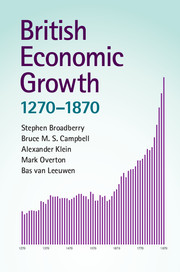Book contents
- Frontmatter
- Contents
- List of Tables
- List of Figures
- List of Appendices
- Preface and acknowledgements
- List of Weights, measures and money
- Prologue: Historical national income accounting
- Part I Measuring economic growth
- Part II Analysing economic growth
- 6 Real wage rates and GDP per head
- 7 Consumption
- 8 The social distribution of income
- 9 Labour productivity
- 10 Britain in an international context
- 11 Epilogue: British economic growth, 1270–1870
- Bibliography
- Index
8 - The social distribution of income
Published online by Cambridge University Press: 05 January 2015
- Frontmatter
- Contents
- List of Tables
- List of Figures
- List of Appendices
- Preface and acknowledgements
- List of Weights, measures and money
- Prologue: Historical national income accounting
- Part I Measuring economic growth
- Part II Analysing economic growth
- 6 Real wage rates and GDP per head
- 7 Consumption
- 8 The social distribution of income
- 9 Labour productivity
- 10 Britain in an international context
- 11 Epilogue: British economic growth, 1270–1870
- Bibliography
- Index
Summary
Introduction
Income distribution in England between 1270 and 1870, as elsewhere in Western Europe, was profoundly unequal due to entrenched inequalities in access to the land, capital, education and political power upon which personal wealth depended. Gender, rank and servility and their differential legal rights were determined at birth. Privilege, patronage and position ensured that rent-seeking was rife, while warfare created opportunities for ransom and plunder to the enrichment of those in command and impoverishment of the vanquished. Everywhere, as a result, there were rich men in their castles and poor men at their gates. Moreover, as van Zanden (1995) and Milanovic and others (2007) have demonstrated, the effect of economic growth was to magnify rather than mitigate these inequalities and widen the income gap between those at the top and bottom of the social pyramid.
The rich became richer as average wealth grew because the more wealth there was the greater the opportunities for those with power and privilege to enrich themselves at the expense of the weak and disadvantaged majority. In Holland one legacy of the prosperity achieved during the Dutch Golden Age was a greatly increased inequality of incomes, which was more marked in towns than rural villages and greatest of all in major cities (van Zanden, 1995). In England, similarly, Milanovic and others (2007) claim that inequality rose with average incomes between 1688 and 1801/03, thereby confirming Kuznets’ (1955) observation that income inequality typically increased during the early stages of economic growth and only declined relatively late in the modernisation process. Prior to 1870, therefore, increasing inequality can be treated, like urbanisation, as a characteristic and unavoidable manifestation of economic growth.
- Type
- Chapter
- Information
- British Economic Growth, 1270–1870 , pp. 307 - 339Publisher: Cambridge University PressPrint publication year: 2015



